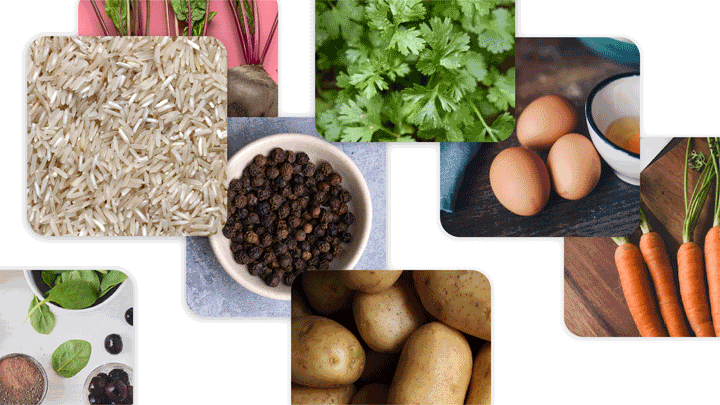Experience, Happenings, Humans
Diversify Your Recipe Repertoire: 5 National Dishes From Our Multinational Team
In honour of Global Diversity Awareness Month and World Food Day today, we’re celebrating in the best way possible: through food! We asked 5 talents from all corners of the globe (literally) to dish about their favourite local dishes and where to eat them in their hometowns. Happy cooking!
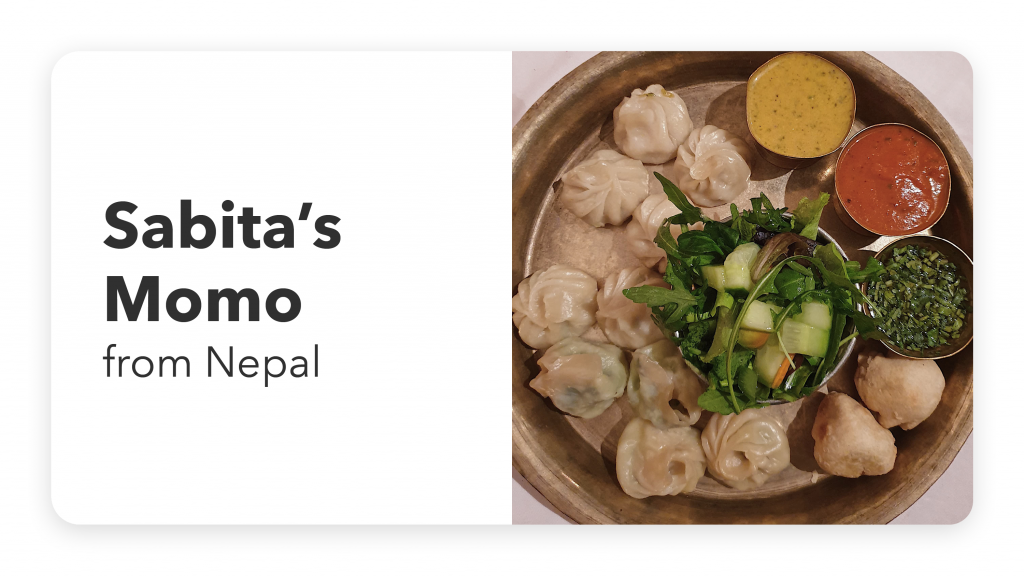
1. What is your favourite local dish? Do you have a recipe?
My favourite local dish from Nepal is “Momo” (similar to dumplings) and I even cook it here in Germany at least once a week (minimum)! Here it is:
Ingredients:
For the dough/wraps:
- 300 gms refined flour
- 80ml water
- 1/2 tsp salt
For the chicken/veg filling:
- 200 g chicken (minced) / finely chopped cabbage and carrot
- 2 small onions + 1 spring onion, finely chopped
- 1/4 tsp black pepper powder
- 1 tbsp oil/ butter
- 1/2 tsp ginger paste
- 1/2 tsp salt
- 20 ml water
Instructions:
- Flour wrap: Wrap can be made at home or buy readymade wrap at an Asian market (wontan wrap or gyoza wrap). For homemade, we need 300 gm of flour, 80ml water and pinch of salt. Mix all together and knead it very well until it becomes a soft dough. Cover it with plastic for a few minutes or while you prepare stuffing.
- Filling/stuffing: You can choose either veg or non-veg. For non-veg, you need 200 g minced meat, 2 small and fine chopped onions, 1 fine chopped spring onion, a small piece of ginger, salt to taste, 1 tablespoon butter and 20 ml water. Mix everything together. For veg, you can use cabbage and carrot and the rest stays the same.
- Wrapping: Once the dough and stuffing are prepared, roll the dough in small circular pieces (as big/small you want). Then fill it with the stuffing and wrap it in a design you like.
- Steaming: You’ll need a special steam pot and tray with small holes for this part. First, put some oil in the steaming tray and place all the momos with enough space between each other. Boil water for 10 mins in the base pot then place the steaming tray on top of the base pot and let it steam for min 15 min in case of non-veg. For veg, 13 min would suffice to steam.
Note: You can use any dip you like – I can recommend either tomato sauce or spicy chill sauce!
2. Why is this your favourite? What’s the story behind it?
This is my favourite dish because I can eat it for all three meals (breakfast – lunch – dinner). There is no specific reason behind it, but because of the taste itself and the combination of Momo with a dip (sauce) is just heaven for me. In Nepal, this dish is so popular that I would say, in both small or big cities, most people will have it for lunch/dinner on a daily basis. The history of it is unclear, but it’s said that this dish was originally from Tibet, where Newar (specific caste of Nepal) used to go for trade and modified the recipe in their own way.
3. Where is the best place to eat it in your hometown/country?
You’ll find it at a lot of small and large restaurants or even in the street market, which is often where it tastes the best. But I usually go to Bota Simply Momo as they have 8+ different dip for Momos and have multiple outlets in different cities across Nepal.
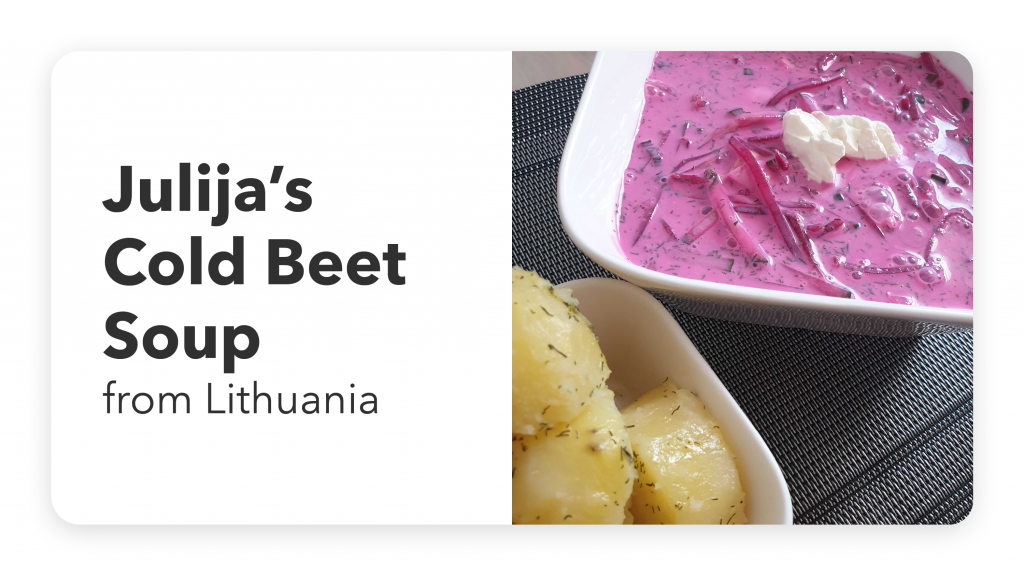
1. What is your favourite local dish? Do you have a recipe?
My favourite local dish from Lithuanian cuisine is a soup called “Saltibarsciai”. Salti barsciai – which means cold borsch.
Ingredients
- 3 medium beets, boiled (save 120 ml/½ cup of the liquid) and cooled in the fridge for at least an hour.
- 2 large cucumbers
- 7 spring onions
- 4 hard-boiled eggs
- 5 litres/6 cups kefir or 2 cups of Greek yoghurt and 4 cups of milk
- Salt and pepper
- Dill
- 4-6 boiled potatoes (can also be fried)
Instructions
- Finely snip six of the spring onions and dill into a large mixing bowl.
- Chop the beetroot and cucumber into small dice or grate it. Add to bowl.
- Slice up the boiled eggs and add to bowl.
- Add the kefir, or whatever you are using (yoghurt, buttermilk, sour cream – it needs to be a kefir liquidity). Add the beetroot liquid.
- Season to taste and chill for 24 hours if possible.
- Garnish with the remaining snipped spring onion and the dill.
- Serve chilled, preferably with fried potatoes on the side.
2. Why is this your favourite? What’s the story behind it?
This soup is usually prepared in summertime, so I think that’s the main reason why it’s my favourite! This bright pink-coloured soup, served cold with boiled or fried potatoes, is quite easy to make. It doesn’t take too much of your time and the taste is unique. This soup is something that really refreshes you in the hot summer days. There is no specific story behind it, however, the oldest recipes for saltibarsciai (cold borscht) are known from the 19th-century mid-range cookbooks!
3. Where is the best place to eat it in your hometown/country?
This is a summer food, so you can easily find it in every small, medium-size or big restaurant during the summer. If you visit Lithuania during the other seasons, you could find saltibarsciai in Etno Dvaras (Vilnius) or Senoji trobele (Vilnius), what is actually the best place to eat it!
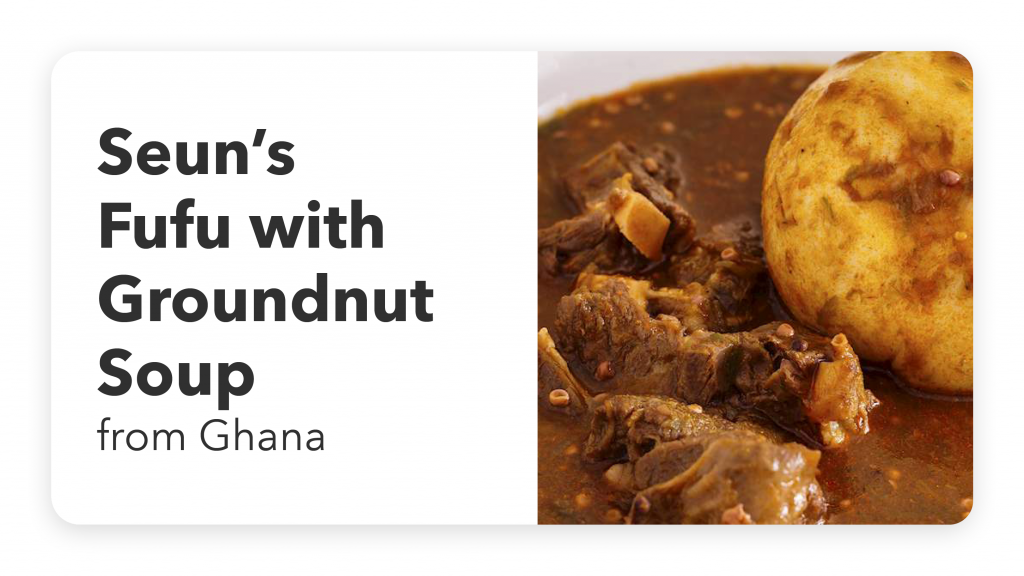
1. What is your favourite local dish? Do you have a recipe?
My favourite local dish from Ghana is Fufu with groundnut soup. Some say peanut soup. I really love this recipe for cooking it!
Ingredients
- 300 g unripened plantain
- 460 g cassava
- 350-450 ml water for blending
- 50 ml water for steaming
Instructions
- First, peel the plantain and cut it into cubes. Peel and scrape the cassava, de-string it and also cut into cubes.
- Next, place the cassava and plantain into the blender. Add water: for now, use 350 ml if you want fufu to be firmer, or 450 ml if you prefer it softer.
- Turn the blender on and process the ingredients into a smooth paste.
- Next, heat the paste in a saucepan over medium heat. Stir constantly with a wooden spatula for 8 to 10 minutes to remove any lumps.
- Now, add the remaining 50 ml of water to the mixture. Reduce the heat to the lowest setting, cover with a lid and steam for another 8 to 10 minutes.
- After that, increase the heat to medium setting and stir. The fufu might look too soft, but it will become firmer as it cools down.
- Transfer the fufu into a bowl and sprinkle one teaspoon of water on the surface to prevent forming a film. Let it cool completely.
- Shape fufu into a ball and serve with soup or stew of your choice.
2. Why is this your favourite? What’s the story behind it?
I can trace my love for this meal to my grandmother. I ate the best version of this meal on visits to her. Other places where I have eaten it never measure up to hers. Fufu has a smooth, stretchy texture. It’s very starchy and heavy, and is as the ideal comfort food for me! I always prefer to eat it as dinner, as part of retiring for the day.
3. Where is the best place to eat it in your hometown/country?
As you can already guess, I’m going to say the best place to eat this is at my grandmother’s place in the Eastern region. But if you’re in Accra, Buka in Osu serves it really well, and also Zion Hut in Tse-Addo.
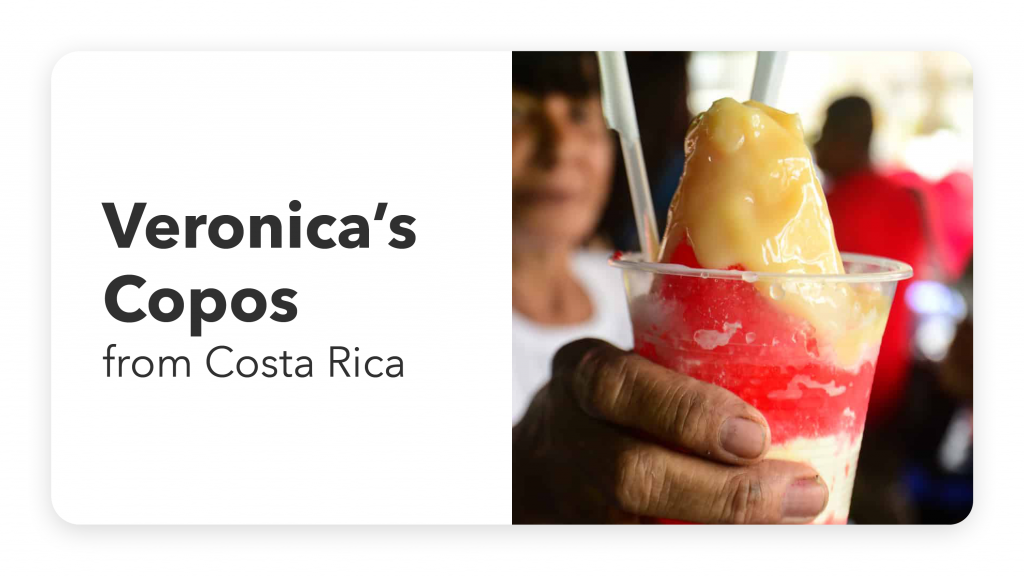
1. What is your favorite local dish? Do you have a recipe?
That’s a very difficult question. I have many favorite local dishes depending on whether it is for breakfast, lunch, snack, dinner, or dessert. So, this time I decided to choose the category dessert. One of my favorite sweets is called “Copo” and his version “Churchill”. Copos and Churchills are the treats you’ll want on a hot, tropical day at a Costa Rican beach. Copos are one of the most popular items that street vendors sell in Costa Rica.
We normally don’t do this at home, since it’s a staple “treat yourself” on the beach or with friends in a park on a hot day. But while writing this I realized how awesome it would be to have Copos here in Germany too. I found this recipe (for 2 jugs):
Ingredients
- 4 cups of frappé ice (use a small crushed ice maker or just put ice cubes in a bag and hit it as hard and as many times as you can).
- ¾ cups of cola/grape/orange or any kind of syrup. In CR the most popular is the cola syrup (red color)
- ½ cup of powder milk
- Around 70 grams of sweetened condensed milk (Milch Mädchen in German).
- Optional: Ice cream, chocolate sauce, waffles. The sky is the limit <3
Instructions
- Put a small layer of crushed ice in a tall glass. Add syrup, then powder milk and sweetened condensed milk, and repeat this until the glass is full.
- Add any of the optional ingredients and enjoy!
2. Why is this your favorite? What’s the story behind it?
It’s not my only favourite dish as there are many others, but I love it because it’s very traditional, refreshing, sweet and it reminds me of my childhood. This is not something you normally get in an ice cream shop or a supermarket. From these two my favorite one is the Churchill. A Copo or Churchill is almost mandatory when I go to the beach and it’s still very common for kids on Sundays after going to church.
The oldest one of both is “the Copo” and Churchill is like the “the Copo 2.0”. The name originates from a shopkeeper who used to ask for a customized “Copo” (which at the time was only crushed ice with syrup) with condensed milk and some other specific ingredients. The locals thought the man resembled the British prime minister Winston Churchill, and often referred to him as Churchill. As a result, his snack of choice was named after him.
3. Where is the best place to eat it in your hometown/country?
Nowadays, you can find Copos and Churchills at almost every beach and park, on the streets and even in restaurants. And even more recently there are “Copo shops” where creativity led them to creating custom versions such as “Christmas Copo” or “Piña Colada Copo”. As I said before, the sky is the limit!
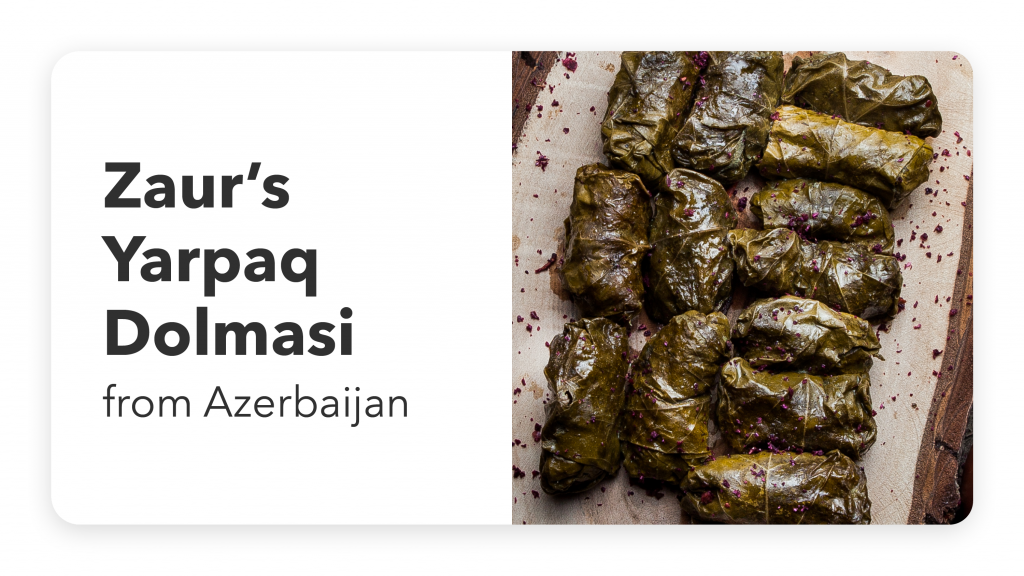
1. What is your favourite local dish? Do you have a recipe?
There are many, but one of my favourites is Yarpaq Dolmasi. There are various types of dolma in Azerbaijani cuisine. In general, the meaning of the word “dolma” is “stuffing”, hence all types of dolma involves filling various vegetables, fruits, or leaves with some kind of a filling of choice. In Yarpaq Dolmasi, grape leaves (or sometimes quince leaves) are used to wrap around the filling which mainly consists of a meat (beef or lamb), rice, and aromatic herbs. You can try different kinds of vine leaves, and each combination has its own specific taste note, but it’s recommended to use the leaves from white vines, as they have lighter colors (but tbh, you won’t lose much if you go with other types of vines). Dolma is usually served with yogurt. Below you’ll find the traditional recipe that serves 4 people:
Ingredients
- 3 tablespoons of butter
- Approximately 80 grape leaves (preferably small, big ones can be cut in half)
For stuffing:
- 500 g minced lamb or beef
- 1 or 2 grated onions (depends on size)
- 1/2 cup round short-grain rice
- 1/2 cup chopped fresh coriander
- 1/2 cup chopped fresh dill
- 1/2 cup chopped fresh mint
- 1 teaspoon salt
- 1/2 teaspoon black pepper
Instructions
- Mix all the stuffing ingredients by hand and set aside to rest.
- Next, take a pan and boil some water in it. In order to make the leaves softer, you will need to keep those leaves in boiling water. If you are using fresh leaves, then you will need to keep the leaves roughly a minute or so. For the canned leaves, the duration is a little longer, around 5 minutes.
- Take a medium-sized pan and put a single layer of leaves on the bottom (to prevent your bottommost layer from burning).
- Now the filling part, take a leaf and place it shiny side down. Then place 1 teaspoon of stuffing close to the stem of the leaf (btw remove the stems). First, fold the sides over the stuffing, then put the stem side over it and roll up tightly.
- Put your stuffed leaves on the bottom of the pan with seam side down close to each other and build up layers.
- Once you are done with the layering, put the butter on top and pour in some water about halfway.
- Put a small plate or lid on top of the layers to prevent the leaves from opening.
- Finally, cover your pan and bring it to the boil. Once it starts boiling, reduce the heat to low-medium and keep it on for another 1.5 hours. Fully cooked leaves become tender – by that time only a very small amount of liquid may remain in the pan.
- Finished dolma is normally served with yogurt. You can also put some chopped garlic into the yogurt, up to you!
- Nush Olsun!
2. Why is this your favourite? What’s the story behind it?
Dolma is one of the most traditional Azerbaijani dishes that is prepared quite frequently in every home. I really like the harmony of various types of leaves and herbs in it, they add a lot more complexity to the taste. And the nice thing is that you can always try out new combinations of leaves and herbs, add your own touch to the traditional recipe and you’d be surprised how different the results might get.
3. Where is the best place to eat it in your hometown/country?
You can visit Shirvanshah Museum Restaurant in the capital city Baku. There you’ll be able to enjoy various authentic dishes from the local cuisine, listen to traditional music, and Mugham – a national folk music genre that takes its roots from an ancient Azerbaijani region of Karabakh. You should also leave some time for a tour of the museum.
Thanks for sharing mouthwatering dishes and stories with us! That’s my menu for next week’s dinner sorted 😉
If you ever try any of these recipes be sure to tag us @lifeattrivago on Instagram and we’ll repost your masterpieces!

